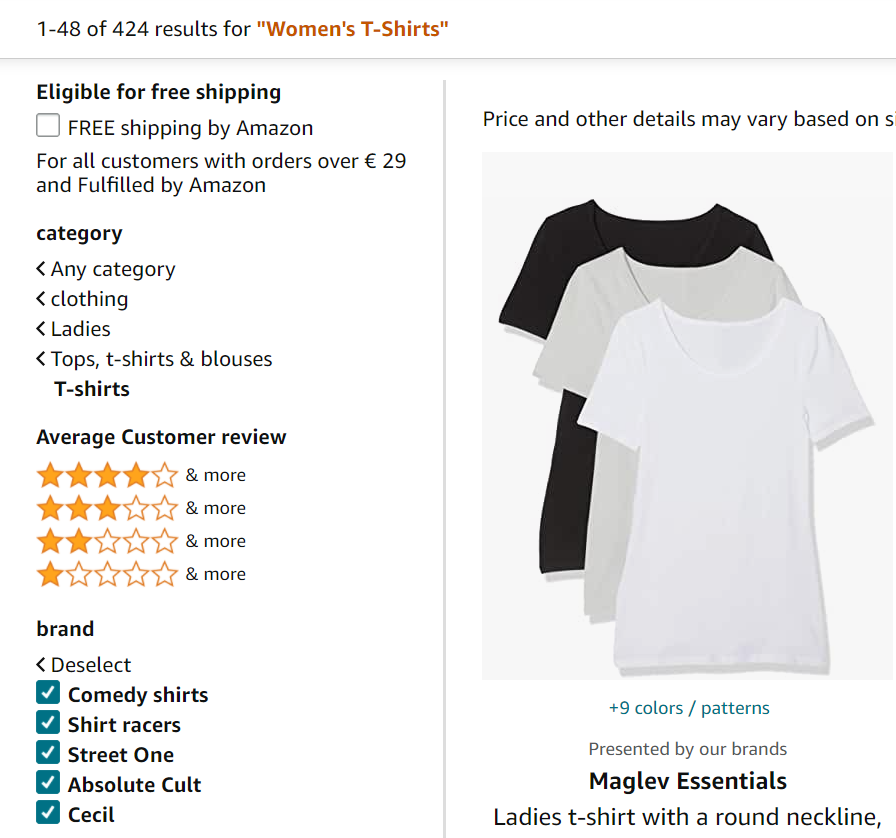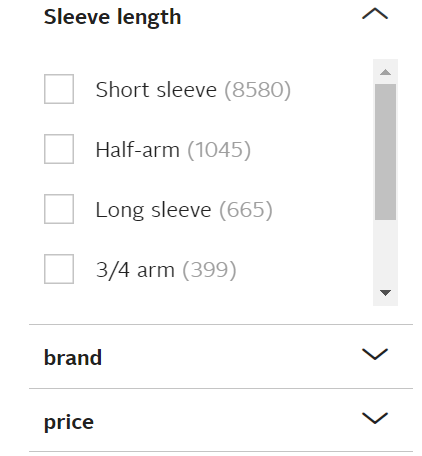Navigation coverage – German ecommerce marketplaces

Navigation coverage on German marketplaces varies radically. Our survey have shown and extremely mixed bag of results from a perfect 100% down to under 20% coverage.
Today we are going to continue with our ecommerce navigation review. In previous posts, we surveyed the navigation infrastructure of six major German ecommerce retailers, and measured their precision level in different product categories.
In this post, we are going to look into the navigation coverage on the German marketplaces we benchmarked last week. By now, we know that setting up your navigation infrastructure is just the first step. Tagging products with relevant attributes is as important to ensure the navigation functions efficiently, and gives your customers the user experience they are expecting. While precision measures how much of the tagging was done correctly, coverage, or recall, measures how many tags were correctly added to products, out of all available and relevant tags.
Once again, we returned to the same websites we visited previously (amazon.de, ebay.de, otto.de, zalando.de, Real.de and Yatego.com), and checked in on the same categories as before (Women’s T-Shirts, Women’s Boots and Smartwatches). In order to measure the coverage level, we first checked how many products in total are offered in each of the categories. Then, we selected an attribute, in which all the values are distinct from each other and cannot be applied to the same product at the same time. For example, in the Women’s T-Shirts category, we selected the Sleeve Length attribute, because it is impossible for a t-shirt to have both long and short sleeves. By contrast, a t-shirt can be correctly tagged with several different values from the Style attribute, for example.
We then checked all the values in the attributes to check the coverage. If all the products are tagged correctly, then the results should contain exactly the same number of products in the category itself.
Amazon.de
We found that in the Women's T-Shirts category in Amazon.de there are more than 3,000 products for sale. We then selected all the values in the Brand attribute, because no t-shirt can be of two different brands at the same time. In this situation, we should get back about 3,000 results, right? Because presumably, all shirts are branded. But we only received 424 results back. This means that out of 3,000+ products in the category, only 424 have been tagged with the Brand attribute, which puts this category at a poor 14.13% coverage. The flip side of this, is that more than 85% of products in this category are not tagged for the Brand attribute.

The Women’s boots category in Amazon.de offers more than 40,000 products. This time we used the Leg Height attribute (because a boot cannot be of two different heights) and checked all of the values in the attribute - “Short”, “Half”, “Long” and “Over the Knee”. Impressively, this time we got back more than 40,000 results, which put it at approximately 100% coverage. For a category with this many products, it is obvious that Amazon.de put in the effort to tag women’s boots.
The Smartwatches category contains over 1,000 products. After refining the results by selecting all the values in the Brand attribute, we were left with only 254 products, for a coverage level of 25.4%. As in the Women’s T-shirts category, the vast majority of the products in this category are not tagged with a brand.

Ebay.de
The Women's T-Shirts category in Ebay.de offers 1,406,290 products. Since a shirt cannot have two different sleeve lengths, we selected this attribute to survey the coverage level of the category. After selecting all the values in the attribute (“Sleeveless”, “Short”, “3/4” and “Long”), there were 1,311,507 products left. This is a pretty good coverage level, at 93.2%.
There are 1,947,785 in the Women’s Boots category. After checking all the values in the Heel Height attribute, which cover everything from flat heel to more than 10 cm, we received back only 893,433 results, which puts this category at 45.5% coverage level, quite a drop from the previous category.
The coverage level of the Smartwatches category was even worse. Out of 52,576 total products in the category, we got back only 13,340 products after we selected each and every case size offered. At only 25.3% coverage level, it means that most of the products in this category are not tagged for this attribute.

Otto.de
Beginning again with the Women’s T-Shirts category, which in total contains 12,030 products, we go to the Sleeve Length attribute. Otto.de saves us the selection by stating the number of products tagged with each of the values. All we have to do is add up all the numbers, and see if it matches the total number of products in the category. In this case, the numbers add up to 10,836 products, which puts this category at a 90% coverage level.

In the Women’s Boots category there are a total of 2,700 products on sale. Looking into the Toe Shape attribute, each of the values (“Round”, “Pointed”, “Square”, “Open”) shows the number of products tagged with it. But adding them all up gives us only 2,140 products. This puts this category at a coverage level of 77.5%. It is not the worst we have seen, but almost a quarter of the products in the category are not tagged with this attribute.
Otto.de offers 520 products in its Smartwatches category. We then used the Storage Capacity attribute to check coverage. We summed up the numbers next to each capacity value on offer, to get back only 103 relevant results. At 19.8% coverage level, the tagging work in this category is lacking.

Zalando.de
In the Women’s T-Shirts category, we found a total of 17,775 products. After selecting all the available Specialty Sizes, we were surprised to receive back the same exact number, which means that every single product in this category is tagged for the Specialty Sizes attribute, for a coverage of 100%.
The Women's Boots category shows a decline in coverage level. Out of 4,216 products in the category, only 3,305 were left after we selected all heights of heel, from flat to 10cm+. At a coverage level of 78.3%, more work needs to be done here.
The Smartwatches category in Zalando.de always gave us trouble, because the website only sells 17 smartwatches. Since no other attribute was applicable here, we used the Brand attribute, and selected all seven brands. Not surprisingly, we received back 17 results, for 100% coverage level.

Real.de
Real.de presented a real problem when reviewing its converge levels. Every time we checked navigation coverage on the German marketplaces, we could easily see the total number of products. Here, there is no indication of the real total number of results as its truncated at 10000. That means that the total number of products in the Women’s T-Shirts category will always be displayed as 10000, unless the you start using facets and decrease the total below 10000. This makes the coverage review slightly skewed and we did not want to compare apples to oranges.
Yatego.com
As before, Yatego.com is extremely difficult to reviwe. The store has almost no navigation whatsoever, and when you finally get to the category you want, Yatego gives you no option to refine the results, offering no attributes. Without such refinement, the customer then needs to sort through all the products in the category, no matter how irrelevant most of them are for him.

Coverage is an important metric. It really demonstrates the ability to buyers to slice huge amount of products and narrow their focus down to a manageable subset. We can see a great variance in navigation coverage on the German marketplaces. While we do expect the marketplaces to ensure the quality of user experience, the real responsibility is on the sellers. Its the seller who must provide the tagged data to the marketplace. In order to improve coverage, you must tag as many products as you can. Of course, if you sell thousands of products this may be a heavy task, but it is sure worth you while - by giving you customers ALL the relevant results, you improve the user experience, and increase your conversion rate.



